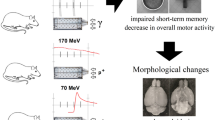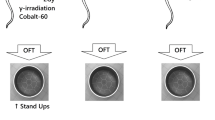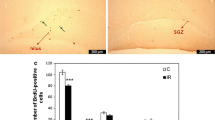Abstract
The effect of long-term exposure to high frequency electromagnetic field (HF EMF) on some somatic and neural characteristics was studied in neurodefective Lurcher mutant (+/Lc) and normal wild type mice (+/+). Both newborn and young adult (3 months) animals derived from two strains (C3H, B6CBA) were exposed to HF EMF (870 MHz) from 1st to 21st day or from 91st to 120th day respectively. In animals of both groups and controls we observed the development of body weight. Moreover, in the HF EMF exposed adult B6CBA animals we studied spatial learning ability, motor functions and the CNS excitability. To investigate specific energy absorption rate (SAR) in experimental animals we have done the basic 3D calculations of the electromagnetic energy distribution in the simplified model of the mouse. The HF EMF exposed animals exhibited mild differences of body weight between them and unexposed controls. The long-term exposure to HF EMF did not significantly influence the ability to learn in the Morris water maze. However, significant lower swimming speed was found in the irradiated +/Lc as well as lower motor activity of +/+ in the open field when compared to controls. No significant differences were found between HF EMF irradiated animals and controls in examination of the CNS excitability and motor functions.
Similar content being viewed by others
References
Adey, W., Byus, C., Cain, C., Higgins, R., Jones, R., & Kean, C., et al. (1999). Spontaneous and nitrosourea-induced primary tumors of the central nervous system in fisher 344 rats exposed to 836 MHz modulated microwaves. Radiation Research, 152, 293–302.
Belyaev, I. Y., Koch, C. B., Terenius, O., Roxtrom-Lindquist, K., Malmgren, L. O., H Sommer, W., Salford, L. G., & Persson, B. R. (2006). Exposure of rat brain to 915 MHz GSM microwawes induces changes in gene expression but not double stranded DNA breaks or effects on chromatin conformation. Bioelectromagnetics, 27(4), 295–306.
Cendelín, J., Schmidtmayerová, B., Štenglová, V., & Vožeh, F. (2004). CNS excitability in normal and neurodefective C3H mice exposed to high- frequency electromagnetic field. In P. Kostarakis (Ed.), Proceedings of Biological effects of EMFs, 3rd International workshop (pp. 866–871). Kos, Greece, 4.-.8.10.2004.
Dubreuil, D., Jay, T., & Edeline, J. M. (2002). Does head-only exposure to GSM-900 electromagnetic fields affect the performance of rats in spatial learning tasks? Behavioral and Brain Research, 129, 203–210.
Hardell, L., Hallquist, A., Mild, K. H., Carlberg, M., Pählson, A., & Lilja, A. (2002). Cellular and cordless telephones and the risk for brain tumours. European Journal of Cancer Prevention, 11, 377–386.
Lai, H., Horita, A., & Guy, A. W. (1994). Microwave irradiation affects radial-arm maze performance in the rat. Bioelectromagnetics, 15, 95–104.
Lai, H., Carino, M. A., & Ushijima, I. (1998). Acute exposure to a 60 Hz magnetic field affects rats’ water- maze performance. Bioelectromagnetics, 19, 117–122.
Salford, L. G., Brun, A., & Persson, B. (1997a). Brain tumour development in rats exposed to electromagnetic fields used in wireless communication. Wireless Networks, 3, 463–469.
Salford, L. G., Brun, A. E., Eberhardt, J. L., Malmgren, L., & Persso, B. R. (2003). Nerve cell damage in mammalian brain after exposure to microwaves from GSM mobile phones. Environmental Health Perspectives, 111(7), 8813.
Sienkiewicz, Z. J., Haylock, R. G., & Saunders, R. D. (1998). Deficits in spatial learning after exposure of mice to a 50 Hz magnetic field. Bioelectromagnetics 19, 79–84.
Töre, F., Dulou, P. E., Haro, E., Veyret, B., & Aubineau, P. (2001). Two-hour Exposure to 2 W/kg, 900 MHz GSM microwaves induces plasma protein extravasation in rat brain. In M. Hietanen, K. Jokela, & J. Juutilainen (Eds.), Proceedings from the 5th international congress of the european bioelectromagnetics association, 6 September 2001 (pp. 43–45). Helsinki: Finnish Institute of Occupational Health.
Vožeh, F., Barcal, J., Cendelín, J., Korelusová, I., Štenglová, V., & žalud, V. (2004). The effect of high-frequency electromagnetic field on some brain function in healthy and neurodefective mice. In P. Kostarakis (Ed.), Proceedings of Biological effects of EMFs, 3rd International workshop (pp. 1113–1120). Kos, Greece, 4.-.8.10.2004.
Wang, B., & Lai, H. (2000). Acute exposure to pulsed 2450-MHz microwaves affects water-maze performance of rats. Bioelectromagnetics, 21, 52–56.
Acknowledgements
The work was supported by the Research Program Project MSM 021620816.
Author information
Authors and Affiliations
Corresponding author
Rights and permissions
About this article
Cite this article
Vožeh, F., Doněk, A., Cendelín, J. et al. Study of high-frequency electromagnetic field effect on some somatic and neuro-behavioral characteristics in healthy and neurodefective mice. Environmentalist 27, 501–504 (2007). https://doi.org/10.1007/s10669-007-9071-2
Published:
Issue Date:
DOI: https://doi.org/10.1007/s10669-007-9071-2




